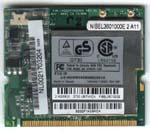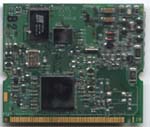For a southbridge solution the J4 uses the 82801BA ICH2 chip from Intel. This chip is the same as the one found on the 845 desktop motherboards. It includes two ATA100 IDE channels and integrated LAN, audio, and four USB 1.1 ports. The southbridge is mounted on the front portion of the J4's motherboard.
To the left of the ICH2 chip lies the J4's mini-PCI slot. When shipped this slot is home to either an internal 56kbs modem or an internal 56kbs modem and 802.11b wireless card. Our system came with the combo card and we were excited to check it out.
As you can see, the modem/802.11b mini-PCI card looks very similar to the mini-PCI modems found in the majority of laptops out there. The only difference between the two seems to be the density of components on the combo card, as the wireless functionality obviously adds complexity to the board. Wireless connectivity is provided by the Intersil Prisim v2.5 chip. The chip offers 11Mbps, 5.5Mbps, 2Mbps, and 1Mbps modes of operation and broadcasts on the 802.11b standard 2.4GHz frequency. The maximum range offered by the Prisim 2.5 is reportedly 120 feet indoors but naturally advertised and actually range differ quite frequently depending on conditions and antenna location.
Speaking of antennas, the J4 offers one internal antenna that connects to the mini-PCI card using a connection located on the top of the front side of the card. A thin wire connects the antenna jack of the combo card to a small black antenna that is stuck via double sided tape to a small space under the J4's right screen hinge. We found that the J4's antenna performed on par with our D-Link DWL-650 PCMCIA wireless network card so it does not appear that the J4's smallish antenna is hurting the computer's ability to link wirelessly.
The modem/802.11b card is capable of accepting two separate antennas but the J4 only makes use of one of the two connectors.

The great thing about the mini-PCI slot's location in the middle of the motherboard is that it is user accessible. All one needs to do in order to get to the slot is remove the J4's keyboard and lift up.
During our testing we got a chance to figure out how much power the wireless connectivity really took but before we even got to that we were pleased to know that the 802.11b was in there and able to connect to our wireless setup without a hitch.
On the right side of the top of the J4's motherboard lies the additional 32MB of video memory for the Mobility Radeon 7500. This brought the J4's video buffer up to 64MB, the most that the Mobility Radeon 7500 can accept. To the right of the four memory chips is the J4's CMOS battery which is of the same size and style as those used on desktop motherboards.
In the middle of the motherboard, right below the BIOS chip, are a set of four small dip switches. We are not sure what the switches do but our J4 came with the first two switches set to off and the last two set to on.
For a storage solution WinBook turned to IBM's mobile hard drives. The J4 that we received was outfitted with a 40GB IBM Travelstar 40GN 9.5mm mobile hard drive. This drive, like the drives in all the other mobile machines AnandTech has reviewed, spins at 4200RPM and has a 12ms access time. Performance of this drive should be on par with other mobile drives out there
As we mentioned before, the speakers on the J4 are mounted in a rather interesting position. Rather than lie directly under the holes located on the front of the J4, the speakers are mounted vertically along the sides of the J4. This means that only about one third of the speaker was lying under the speakers holes. The remaining two thirds of the speaker was creating noise that blasted up into the J4's case.
In the picture below you can see the J4's speaker, which is identical to the speakers found in the vast majority of notebooks out there, as well as a black outline showing where the speaker is actually mounted in the system. Obviously sound on the J4 was a bit muffled by the lack of speaker holes over the majority of the speaker.
The battery on the J4 had to be made large to sufficiently power the Pentium 4 2.4GHz processor at the helm. The battery pack stretches almost the entire length of the system and takes up about one fourth of the system's bottom. The capacity of the battery is massive, operating at 14.8 volts and 5880mAh of power. The battery contains 12 Lithium Ion cells and has about the same power as the large battery used to power the Toshiba Satellite 1905-S277.
















2 Comments
View All Comments
Poopship - Tuesday, December 18, 2012 - link
i-BuddiePoopship - Tuesday, December 18, 2012 - link
Why was everything expensive crappy plastic garbage. desktop p4 lol